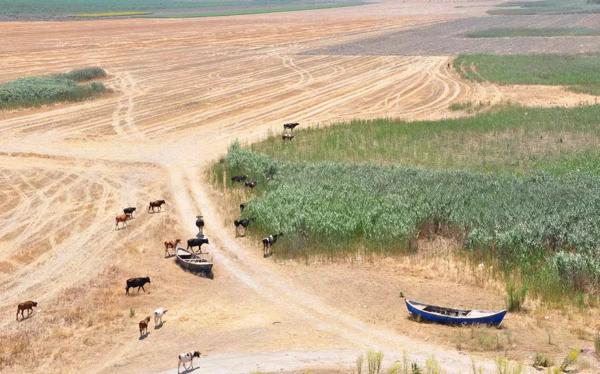
World & Indian History
How Did Dam Development and Climate Change Kill Lake Marmara?
Lake Marmara, which initially stretched over 17 square miles in Turkey's western Manisa region, has lost its beauty and old majesty because 98% of the lake has dried up over the span of the last ten years.
The lake, which was once a bird sanctuary and home to millions of fish species as well as endangered animals in the region, has now spread out like a desert in the middle of nowhere.
The region used to be home to thousands of tourists due to its biological richness, and it used to provide jobs for fishermen; currently, the carcasses of fishing boats remain in the Lake's biodiversity tomb.
Approximately 300,000 tonnes of fish could be captured annually with more than 400 fishing boats when the lake's natural qualities were protected.
The lake basin was home to over 150 bird species and over 20,000 waterfowls, providing a seasonal habitat, shelter, and breeding location, according to environmentalists.
In the early days of the 2000s, 25 NGOs and research institutions from the Mediterranean Alliance for Wetlands and BirdLife International partners came together to warn the Turkish government and key international authorities about the impending loss of this biodiversity hotspot of global importance.
The Turkish government designated Lake Marmara as a wetland of national importance in 2017. It is internationally recognized as one of Turkey's 305 Key Biodiversity Areas (KBAs) and 184 Important Bird Areas (IBAs). Furthermore, the lake fits the criteria for designation as a Ramsar Site, which is a wetland of worldwide importance.
However, the lake is now dead, and it is being actively transformed into agricultural land. The region is presently experiencing drought and other climatic challenges as a result of the drying up of lake water, which used to play a balanced role in moderating the region's climate.
Reasons for Lake Marmara's Drought
Lake Marmara is drying up due to two factors: dam infrastructure, which transfers water to other locations, and climate change, which causes the temperature of the lake to rise.
During the time of Recep Tayyip Erdogan, bolstered the construction of dams in his country, and his government built around 20 dams during the last 20 years of rule. The Gordes Dam on the Gordes River is the primary driver of Lake Marmara's demise.
The dam's construction began in 1998 when a $170 million contract was granted to Kocoglu Construction. It took more than a decade to create, yet it began leaking water almost immediately after it opened in 2009.
Cracks emerged at the base of the dam's 5.5 million cubic meters (about 1.5 billion gallons) reservoir and in the tunnel that delivered the water to its destinations after the dam was completed. Even after the cracks were repaired in 2015, the reservoir continued to leak and the lake began to evaporate.
The reservoir project was supposed to pump 60% of its water to the nearby town of Izmir, where the population grew from 1.2 million to 3 million in the last decade, and the remaining 40% to irrigate 150,000 hectares (about 580 square miles) of surrounding farmland, where peaches, grapes, and walnuts are grown. However, nothing had transpired, according to Tunc Soyer, the mayor of Izmir who is opposed to Erdogan.
What happened was that once the dam was built, the water began to evaporate, causing an increase in temperature, the winter rainfall stopped completely, and the lake dried up completely in 2021.
This occurrence is comparable to the drying up of the Aral Sea.
During the Cold War days in the 1960s, the lake had already dried up as a result of unsustainable cotton production that had begun less than 40 years before.
The Amu Darya and Syr Darya rivers were diverted from supplying the Aral Sea to irrigate the desert in an effort to grow cotton, melons, rice, and grains.
The region's 3.5 million residents have seen their health, jobs, and living situations deteriorate. The once-thriving fishing and canning industries have vanished, replaced by anemia, high infant and mother mortality, and crippling respiratory and intestinal illnesses.
The dam has wrecked the region's livelihood and the old cave city of Hasankeyf, which is located 25 miles northwest.

0 Comments